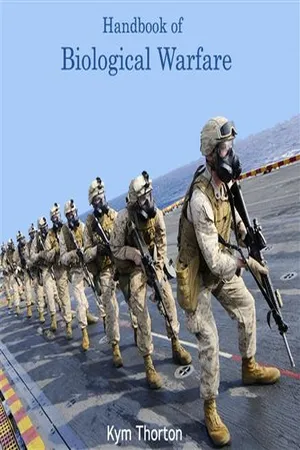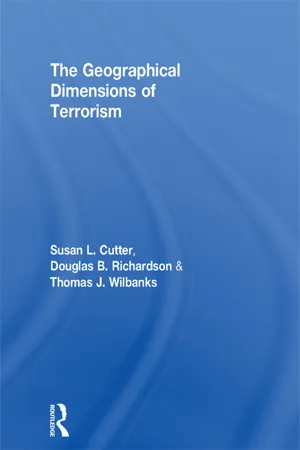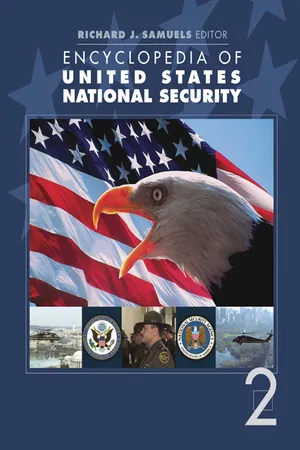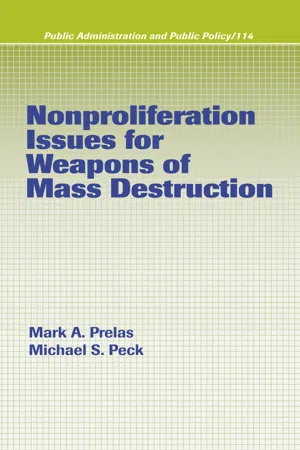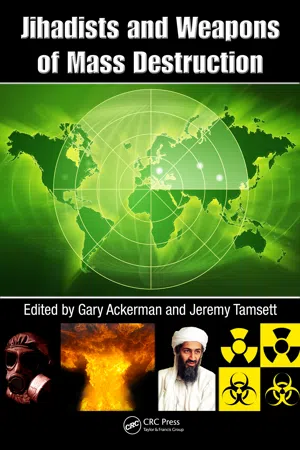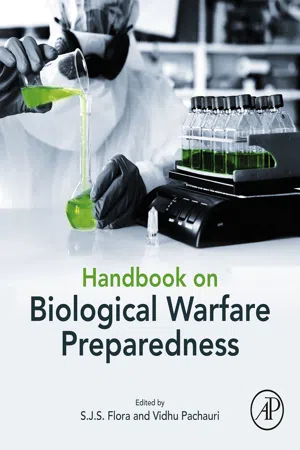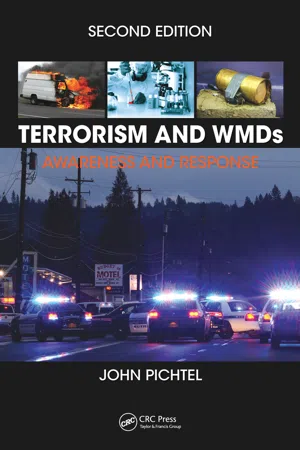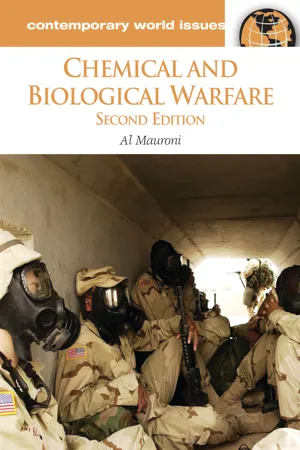Biological Sciences
Biological Warfare
Biological warfare involves the use of biological agents, such as bacteria, viruses, or toxins, as weapons to cause harm to humans, animals, or plants. This form of warfare can lead to widespread illness, death, and disruption of ecosystems. It poses significant ethical and security concerns and is regulated by international treaties to prevent its use.
Written by Perlego with AI-assistance
Related key terms
1 of 5
11 Key excerpts on "Biological Warfare"
- No longer available |Learn more
- (Author)
- 2014(Publication Date)
- University Publications(Publisher)
________________________ WORLD TECHNOLOGIES ________________________ Chapter 1 Biological Warfare Biological Warfare (BW) — also known as germ warfare — is the deliberate use of disease-causing biological agents such as bacteria, viruses, fungi, or biological toxins, to kill or incapacitate humans, animals or plants as an act of war. Biological weapons (often termed bio-weapons or bio-agents) are living organisms or replicating entities (viruses) that reproduce or replicate within their host victims. Entomological (insect) warfare is also considered a type of BW. Biological weapons may be employed in various ways to gain a strategic or tactical advantage over an adversary, either by threat or by actual deployment. Like some of the chemical weapons, biological weapons may also be useful as area denial weapons. These agents may be lethal or non-lethal, and may be targeted against a single individual, a group of people, or even an entire population. They may be developed, acquired, stockpiled or deployed by nation states or by non-national groups. In the latter case, or if a nation-state uses it clandestinely, it may also be considered bioterrorism. There is an overlap between Biological Warfare and chemical warfare, as the use of toxins produced by living organisms is considered under the provisions of both the Biological Weapons Convention and the Chemical Weapons Convention. Toxins and Psychochemical weapons are often referred to as midspectrum agents . Unlike bioweapons, these midspectrum agents do not reproduce in their host and are typically characterized by shorter incubation periods. Overview Offensive Biological Warfare, including mass production, stockpiling and use of biological weapons, was outlawed by the 1972 Biological Weapons Convention (BWC). - No longer available |Learn more
Biological Weapons
Coronavirus, Weapon of Mass Destruction?
- DR. U C Jha, Dr K Ratnabali(Authors)
- 2021(Publication Date)
- VIJ Books (India) Pty Ltd(Publisher)
It is difficult to say with certainty that such acts were a part of natural epidemic or planned biological attacks. The reason being, before the advent of modern microbiology at the end of the 19th century, little was known about the pathogens and truth might have been manipulated for political reasons. 4 Before discussing further on biological agents and the history of the Biological Warfare, a few basic terms need to be defined: Biological Agents : The 1969 United Nations study for the Secretary-General states, “Bacteriological (biological) agents of warfare are living organisms, whatever their nature, or infective material derived from them, which are intended to cause disease or death in man, animals or plants, and which depend for their effects on their ability to multiply in the person, animal or plant attacked.” 5 This definition does not include toxins in the term biological agents. Biological Weapons : Biological weapons refer to munitions, equipment or other means of delivery including bombs, aircraft spray tanks and other devices, intended for use in the dissemination of biological agents and toxins for hostile purposes. The principal means of dissemination are as an aerosol to be inhaled by a target population or as a spray to be deposited on crop plants. An aerosol is a suspension in air of particles so small that they travel with air currents instead of settling to the ground. Biological Warfare : Biological Warfare is a planned and deliberate military employment of pathogenic strains of microorganisms such as bacteria, viruses, 6 or their toxins to produce death, temporary incapacitation, or permanent harm in humans or to kill or damage animals or plants for a military objective. Bioterrorism : The US Centre for Disease Control has defined bioterrorism as the deliberate release of viruses, bacteria or other agents used to cause illness or death in people, and also in animals or plants by non-state actors - eBook - ePub
- Susan L. Cutter, Douglas B. Richardson, Thomas J. Wilbanks(Authors)
- 2014(Publication Date)
- Routledge(Publisher)
N THE BEST OF ALL WORLDS , differences among peoples would be negotiated and conflict would be settled peacefully. Although there have been some periods of well-intentioned international reconciliation of differences during the last 100 years, on the whole the record is abysmally poor. Currently, a number of countries, spurred by national or ethnic aspirations on the one hand and intransigence and control on the other, are stimulating explosive situations that could have devastating results. One of the threats to the human and environmental well being of the planet is Biological Warfare (BW), the use of biological agents as weapons that could cause disease and deaths in sufficient numbers to greatly impact a city or region. These include agents that have high potential for person-to-person transmission, are highly infectious, are generally available, can be produced in large quantities, and do not have a vaccine or have a vaccine available in limited supply (Borio and others 2002).In terms of its potential for mass destruction, BW is generally deemed less of a threat than nuclear or chemical warfare. Nonetheless, it is important to survey every potential type of warfare to prepare for any eventuality in our quest for survival. Most of the academic disciplines have something to offer in this regard. It is easy to see that chemistry, for example, can tell us a great deal about chemical weapons and their possible effects on humans. The transportation sciences can inform us about the delivery of weapons, either for weapon supply centers or for direct attack. Epidemiologists and entomologists can explain the potential of using virus-laden insects as weapons of war. Geographers bring perspective, the use of mapping technologies, and spatial analytical techniques to the table of understanding of BW. Much, but not all, of this geographic knowledge is embodied in what is called the geographic information science (GIScience or GISc). - Richard J. Samuels(Author)
- 2005(Publication Date)
- SAGE Publications, Inc(Publisher)
The Department of Homeland Security is responsi-ble for maintaining biosecurity in the United States. In addition, the Centers for Disease Control and Preven-tion provide information on biodefense measures for private citizens. Both of these agencies thus occupy central roles in protecting the United States from bioterrorism and ensuring the future health of the environment. See also Anthrax; Biological Weapons and Warfare; Biological Weapons Convention; Bioterrorism; Homeland Security, Department of Further Reading Croddy, Eric. Chemical and Biological Warfare: A Compre-hensive Survey for the Concerned Citizen. New York: Copernicus Books, 2002. Davis, Jim A., and Barry R. Schneider (eds.). The Gathering Biological Warfare Storm. Westport, CT: Praeger, 2004. Mangold, Tom, and Jeff Goldberg. Plague Wars: The Terrifying Reality of Biological Warfare. New York: St. Martins Press, 2001. BIOLOGICAL WEAPONS AND WARFARE Warfare waged with biological agents that have been placed in weapons. Biological Warfare entails the use of pathogens, or disease-causing organisms or substances. These pathogens may be living organisms, such as the bacterium that causes anthrax; viruses, like the one that causes smallpox; or toxins that have been processed from microbes or extracted from plants, such as ricin from the castor bean. To be used effectively, these agents must then be weaponized, or designed into effi-cient delivery systems so that sufficient quantities are inhaled, ingested, or make surface contact in quantities that can incapacitate, injure, or kill. USES OF BIOLOGICAL WEAPONS Biological weapons can be used against an army or a civilian population, livestock or work animals, crops or jungle cover. Often the goal of Biological Warfare is not to cause large numbers of casualties, but to sow confusion and fear, and to cost the enemy significant time and resources.- Mark A. Prelas, Michael Peck(Authors)
- 2005(Publication Date)
- Routledge(Publisher)
157 4 Characteristics of Biological Weapons 4.1 BIOLOGICAL AGENTS Biological agents are defined as living organisms or toxins derived from biological organisms that can adversely affect people, ani-mals, plants, and strategic materials (e.g., an agent that might attack rubber or gasket materials). 1 Throughout history, the bal-ance between infectious disease and humankind has been tenuous. Disease has killed more humans than war. World War II was the first major conflict where more combatants died from directly inflicted wounds rather than from disease or infection. One of humankind’s greatest achievements during the 20th century was medical science advancements that shifted the delicate balance between microbe and man in favor of humankind. Our understand-ing of the microbe has led to significant discoveries in antibiotics, vaccines, and treatments. These discoveries also have a direct impact on the use of microbes in warfare. As discussed in Chapter 2, 20th-century science has successfully transformed certain bio-logical agents into weapons of mass destruction (WMDs). The world pharmaceutical market is enormous, representing estimated total sales of more than $500 billion in 2004. The indus-try growth rate tops 8%, with the bulk of the sales in North America (Figure 4.1). With the growing economies of China and India, there are also promising prospects for future growth in Asia. With the growth of the pharmaceutical industry, there is also a large amount of equipment and expertise widely distributed around the world. Much of this technology is transferable to destructive pur-poses. The proliferation of biotechnology was inevitable. For the 158 Prelas and Peck most part, this type of proliferation is for the benefit of humankind. However, the knowledge can be misused for the production of weapons of mass destruction. It is for this reason that the authors view bioweapons as the greatest proliferation risk for the devel-opment of weapons of mass destruction.- eBook - PDF
- Gary Ackerman, Jeremy Tamsett, Gary Ackerman, Jeremy Tamsett(Authors)
- 2009(Publication Date)
- CRC Press(Publisher)
It will then examine the threat of jihad-ist terrorism vis-à-vis biological weapons in the context of capabilities and the minimum requirements for success. In addition, the chapter examines pathways to acquisition to pro-cure biological weapons as well as known attempts by jihadists to embark down these pathways. UNDERSTANDING BIOLOGICAL AND TOXIN WEAPONS Biological weapons (BW) are produced from pathogenic microorganisms or toxic sub-stances of biological origin, formulated in such a way that they are capable of disabling and/or killing people, crops, and livestock, and combined with an apparatus/method used to deliver the biological harm to the target population. Biological agents are the microorganisms and toxins that cause disease and could be used for manufacturing bio-logical weapons. The biological agents that have been associated with weapons develop-ment can be divided into five key groups: bacteria, viruses, rickettsia, fungi, and toxins (bacteria, viruses, and toxins are the most well-known types of BW agents). Table 6.1 identifies some of the more well-known agents that have been associated with biological weapons development. The difficulty in detecting biological terrorist attacks is that symptoms of illness do not appear immediately, as would occur in a chemical, nuclear, or conventional weapon attack. Because most biological weapons consist of living organisms, symptoms will occur only after an incubation period that may last days to weeks. 2 Many times, the ini-tial symptoms could appear as a common cold or influenza and might be mistaken for a normal outbreak of infectious disease. Until large numbers of individuals report illness, the attack could go undetected. This is especially likely to be the case during annual cold and flu season. If the agent used can translate as a communicable disease, the infec-tion could spread rapidly across a large population before health preventative measures - eBook - ePub
- S.J.S. Flora, Vidhu Pachauri(Authors)
- 2019(Publication Date)
- Academic Press(Publisher)
Humanity should be the biggest concern for social well-being, irrespective of anything. Indeed one must not forget the history of largest biological weapons accidents, like anthrax outbreaks and plague victims, which have taught us how bacteria played a significant role in destruction of a civilization (Dols, 2019 ; Jernigan et al., 2002). Although many steps have been taken to limit the use of bacterial biological agents, such protocols are still in the initial stages in terms of strengthening their implementation. It must always be remembered that biological weapons are considered not only as a warfare agent, but also as a threat for human beings’ survival in the near future (Tournier et al., 2019). Hence, despite the research and production, political involvement, and self-benefiting treaties, there must be complete elimination of the practice of bacterial warfare. Warfare agents The term “warfare agents” denotes exposure to chemical, nuclear, and biological agents during military service, which potentially cause harm to a large number of humans or human-made structures like buildings, natural structures like mountains, or the biosphere. The main purpose behind the use of warfare agents is to terrorize enemies. Warfare agents are broadly categorized in four types: chemical, biological, radiological, and nuclear, abbreviated as CBRN (Fountain, 2018). The threat of use of these agents by militants, either individually or in combination formats, such as biological and chemical warfare, may make it a difficult challenge to counter. Biological Warfare agents as a preferred weapon of destruction Biological Warfare agents can be easy to use, cost-effective, and, most importantly, difficult to detect. The cost of Biological Warfare agents is much lower, even less than 0.05% than that of conventional warfare agents (Beeching et al., 2002 ; Danzig and Berkowsky, 1997). Moreover, very simple technology is needed for its production - Available until 3 Mar |Learn more
Terrorism and WMDs
Awareness and Response, Second Edition
- John Pichtel(Author)
- 2016(Publication Date)
- CRC Press(Publisher)
103 4 Biological Agents You will be well advised to infect the Indians with sheets upon which smallpox patients have been lying, or by any other means which may serve to exterminate this accursed race. Jeffery Amherst, 1717–1797 For the life of me, I cannot understand why the terrorists have not attacked our food supply, because it is so easy to do. Tommy Thompson, 2004 INTRODUCTION Biological Warfare has been known, and applied to great effect, for millennia. In recent years, however, with enhanced knowledge of microbiology, culturing techniques, and means of dissemination, the threat has become acute. Bioweapons have been used by ter-rorists, and several nations are known to be manufacturing tactical biological weapons. Therefore, awareness of this potential threat by first responders, medical care providers, public health agencies, elected officials, and ultimately the general public, including how to identify such weapons and to respond appropriately, is essential. CATEGORIES OF BIOTERRORISM AGENTS Given the events of the past two decades, it is essential that the U.S. public health sys-tem and primary healthcare providers be prepared to address a wide range of biological agents, including pathogens that rarely occur in the United States. Even before the bioter-ror attacks of 2001 in which anthrax spores were deliberately released in the U.S. postal 104 TERRORISM AND WMDs system, public health officials expressed concerned regarding the potential for such an event. In 1999, the U.S. Centers for Disease Control and Prevention (CDC), one of the key units of the Department of Health and Human Services, devised a classification scheme for major biological agents that terrorists could use to harm civilians (please see the lists of categories of CDC biological agents and examples of CDC category A, B, and C agents). - eBook - PDF
Chemical and Biological Warfare
A Reference Handbook
- Albert J. Mauroni(Author)
- 2006(Publication Date)
- ABC-CLIO(Publisher)
While the former Soviet Union is believed to have researched “designer” BW agents or bioengineered agents, there is a great difference of opinion about whether these agents would work on the battlefield. Advances in biological technology may create the possibility of BW agents that are more potent and that are resistant to antibiotics and vaccines. Other people dismiss the threat, noting that engineered pathogens may struggle to survive or quickly lose their potency when released into a natural environment. By far, the natural diseases, culled out of nature using equipment that could be dualuse for pharmaceutical research (or even for brewing beer), seem to be the major military threat. BW agents have been developed for specific effects against humans, animals, plants, and even materials. They can be divided into pathogens, living organisms, and toxins, which are chemical by products of biological organisms. As with CW agents, they can also be divided into the two classes of lethal and incapacitating agents. There are thousands of biological organisms that have detrimental effects on people, but the list of agents that usually show up in a nation’s offensive BW program is relatively short. The ideal BW agent should be hard to detect, consistent in its predicted effect on the target, possible to produce cheaply in mass quantities, able to be disseminated over a large area, stable while in storage and in transportation, and with a short and predictable incubation period. Ideally, the target population should have little to no immunity, whereas the using force should have its military and civilians inoculated (Dando 1994, 33). These requirements Page 159 reduce the list to fewer than thirty or so prime candidates, which the CDC puts on a list as restricted agents to control their handling and transportation (OHS— Interstate Shipment of Etiologic Agents, accessed 2003). We can break the pathogens down into classes of bacteria, viruses, rickettsia, and fungi. - eBook - PDF
Deadly Cultures
Biological Weapons since 1945
- Lajos Rózsa, Mark Wheelis, Lajos Rózsa, Malcolm Dando, Mark WHEELIS, Lajos Rozsa(Authors)
- 2009(Publication Date)
- Harvard University Press(Publisher)
How would scientists reconcile such an enterprise with their moral convictions? But many scientists, even those who detested war, had no problem. Theodore Rosebury, a distinguished biologist, resolved his moral dilemma by invoking social responsibility and patriotism. 8 During this period advocates of BW preparedness defined what they saw as its advantages, establishing a theoretical base for its development. The case for BW was often argued simultaneously with the case for chemical and radiological warfare. Five arguments shaped the case. First, the USSR, with its large conventional forces, could overrun Europe and a large part of the Near and Middle East within six months. Second, toxic weapons could be used to counter Soviet conventional military su-periority. Third, these weapon systems would not destroy property, and thereby freed the victor from the task of urban reconstruction. Fourth, they would be useful in obtaining surprise over the enemy. Fifth, they could have considerable psychological impact. 9 Among these systems, BW were seen as superior. 10 They would shorten a war by threatening a “significant proportion of a populace,” thereby leading to a negotiated settlement. 11 However, before there could be any consideration of policy, the value of BW as a military option had to be examined. On 16 March 1948 Secretary of Defense James Forrestal informed President Truman that the Joint Research and Development Board rec-ommended a “review of national policy on Biological Warfare.” Priority would go to its military value. Once this estimate was completed, broad policy questions would “be in order.” 12 The US Biological Weapons Program 11 Given the inherent difficulties of the task, it is not surprising that American CBW policy remained unchanged throughout the 1940s and early 1950s. The issue was reviewed by the Joint Chiefs of Staff (JCS), who recommended that the policy of retaliation be continued as “an in-terim measure . - eBook - PDF
Pathogens for War
Biological Weapons, Canadian Life Scientists, and North American Biodefence
- Donald H. Avery(Author)
- 2017(Publication Date)
- University of Toronto Press(Publisher)
They were particularly interested in this latter trial since it involved the testing of viral agents such as Venezulan equine encephalitis (VEE), and vaccinia, used as a stimulant for the much-feared variola virus (smallpox). On the policy side, the Defence Research Board monitored ongo-ing debates in the United Kingdom about the relative importance of biological and nuclear weapons. There were several stages in this competition. Until October 1952, when the UK exploded its first atomic bomb, supporters of the bioweapons option could successfully argue that BW was crucial for the country’s national security, particu-larly since the Air Ministry was actively promoting the development of a 1,000-lb BW cluster bomb. As a result, MRD Porton received consid-erable financial support to expand its laboratory facilities, hire new scientific staff, and make plans for the mass production of bulk patho-gens in a large-scale pilot plant. On the other hand, there was abun-dant evidence that Britain’s military hierarchy regarded bioweapons as a rather dubious stopgap measure, until the country acquired a nuclear deterrent. As one report to the British Chief of Staff pointed out, “lest over-optimistic results should be expected from [BW] retali-ation on a massive scale, it should be borne in mind that the large-scale use of Biological Warfare from the air as a weapon of war has not been tried.” 114 Although Porton’s BW operation continued to function after 1952, it was completely eclipsed by the rapidly expanding American program, which, as David Henderson noted, “had become very offensive minded … [and] the Services had gained complete con-trol of BW matters.” 115 78 Pathogens for War Medical Internationalism and Civil Defence Canada and the World Health Organization In their attempts to prevent Biological Warfare, Canadian scientists also worked closely with the newly created World Health Organization.
Index pages curate the most relevant extracts from our library of academic textbooks. They’ve been created using an in-house natural language model (NLM), each adding context and meaning to key research topics.
